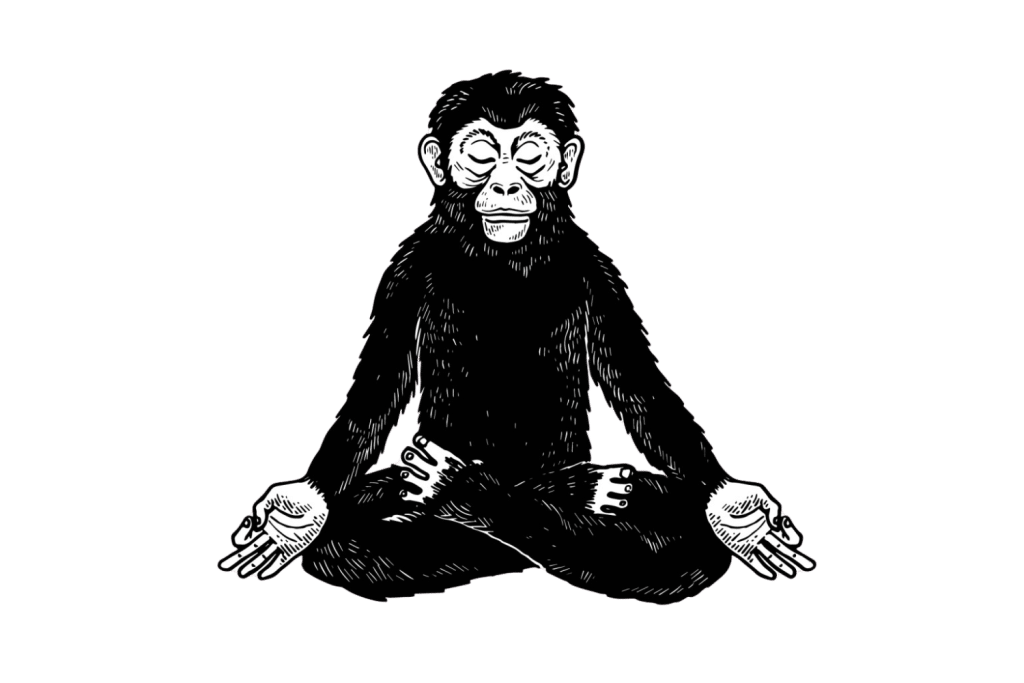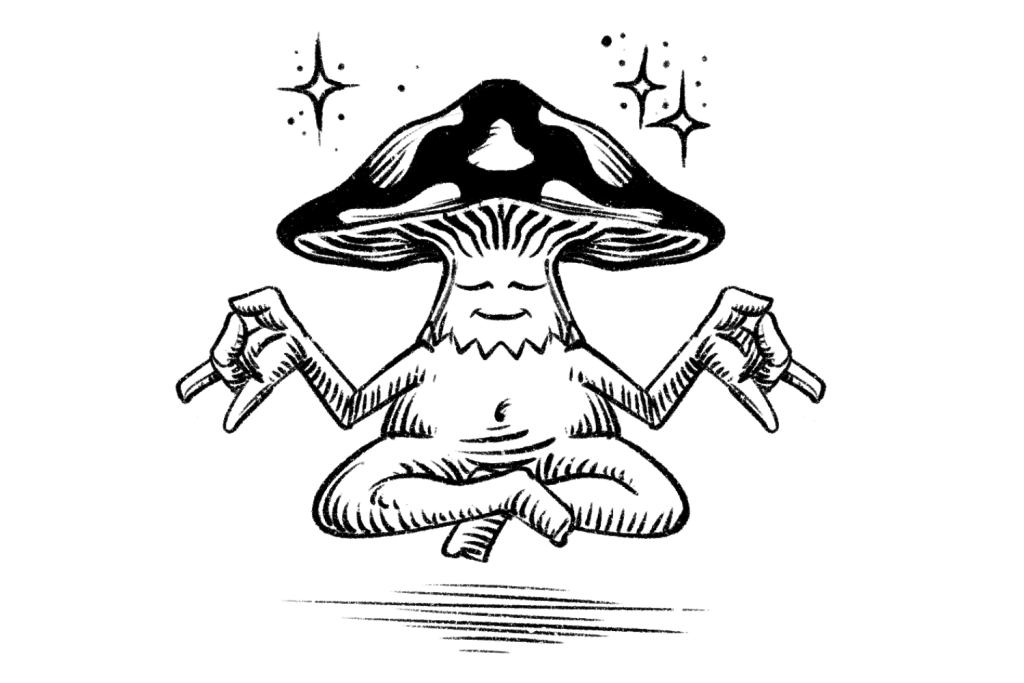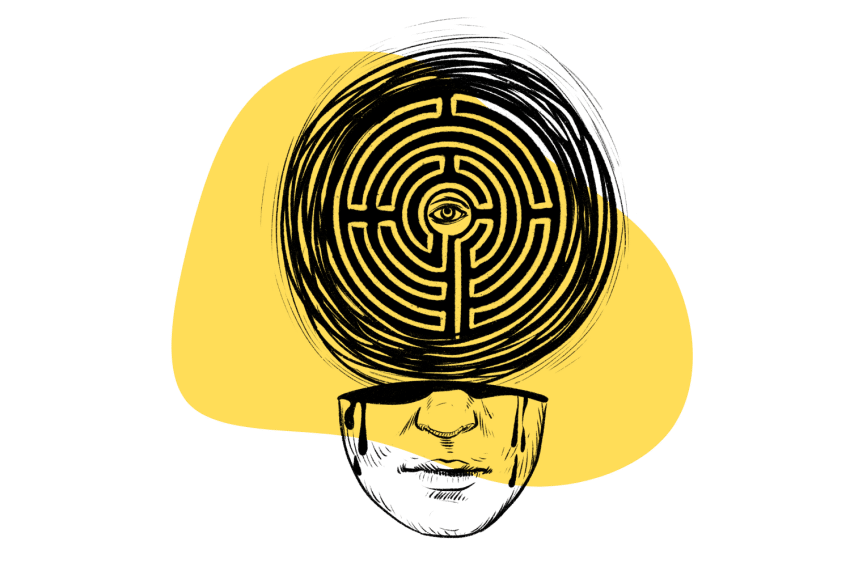The Art Of Mindfulness: How Psychedelics Can Help You Live In The Moment
“Mindfulness is awareness that arises through paying attention, on purpose, in the present moment, non-judgementally.” — Jon Kabat-Zinn
In today’s fast-paced world, many struggle to let go of distractions and fully engage with the world. According to a Harvard statistic, nearly 47% of our waking hours aren’t spent focusing on the present task.
During this time, the mind wanders — preoccupied with thoughts of the past or the future [1]. In this study, participants reported being less happy when their minds wandered, even though the thoughts weren’t necessarily negative.
The remedy? To live in the moment — which is, of course, much easier said than done.
In this article, we’ll explore the art of mindfulness for living in the moment and delve into how psychedelics can help us fully engage with the here and now for a more meaningful life.
Why Does Our Mind Have A Tendency Wander?
It turns out our brains are wired to spend a lot of time thinking about things outside of the present moment.
Scientists call this the default mode network (DMN), a network of brain regions that work together when our minds are at rest.
This system is a sort of “mental playground,” allowing us to have internal dialog, reflect on memories, plan for the future, and even engage in creative thinking.
It’s what we use to define our sense of self and contemplate our place in the world, and psychologists call this internal dialog the “ego.”
However, while the DMN is helpful for all these functions, it becomes a double-edged sword.
If we’re not conscious, we can get stuck in a cycle of negative thoughts, like ruminating on the past or worrying about the future. These fixations of our inner world can make it difficult to live in the present and enjoy the world and people around us.
What Does It Mean To Be Present?
For many, it’s a struggle to have the mind and body occupy the same space simultaneously.
To be present means to be fully engaged and aware of your current environment and experiences, which requires letting go of tangent thoughts about the past or future and redirecting your attention solely to the present moment.
It sounds so simple, yet it’s a difficult state to achieve — and even harder to maintain.
However, with practice, living in the moment can become a habit that leads to a more fulfilling life.
How Psychedelics Can Help
Psychedelic drugs like LSD (lysergic acid diethylamide), psilocybin, DMT (dimethyltryptamine), and mescaline profoundly affect the brain, altering one’s perception of time, space, and thought patterns. The effects of which can result in a wide range of experiences that can be pleasurable, insightful, and even frightening.
These psychedelic drugs are currently being researched for their use in psychedelic-assisted therapy to address difficult-to-treat mental health conditions such as anxiety, depression, and PTSD (post-traumatic stress disorder) [2].
Most notably, these substances have been shown to reduce activity in the default mode network. But at the same time, other brain regions involved in sensory processing and emotional regulation light up, which allows the mind to become more fluid and receptive to the present moment — freeing itself from habitual thought patterns [3].

This may explain why it’s so common to experience a surge of creativity, a profound sense of unity with something greater than themselves, as well as a deep appreciation for life and a renewed sense of purpose on psychedelics.
In Aldous Huxley’s book, The Doors Of Perception, he describes the DMN as a “reducing valve” that filters our perception of reality and limits our consciousness. Under the influence of psychedelics, the filter is temporarily disabled, giving the user access to the world in a more direct way — i.e., becoming truly present.
While the hallucinatory effects and euphoria of psychedelics on the brain are temporary, many people report feeling lasting effects on their mood, behavior, and outlook on life from their psychedelic experiences long after the trip [4].
This doesn’t mean we must use psychedelics daily to live in the moment.
The long-term effects of many of these psychedelic drugs aren’t well understood and can be dangerous for some people.
Bad trips and psychological distress are very real and possible outcomes of psychedelic drug use — and they’re difficult to predict. This is why it’s important to use psychedelics in a safe and controlled environment, preferably with the guidance of a trip sitter or a trained professional.
The good news is that you don’t even need to explore psychedelics to get better at living in the moment.
How To Practice Mindfulness
Many Eastern spiritual practices, including Buddhism, Hinduism, and Taoism, emphasize the importance of living in the present, which is deemed a pathway to enlightenment.
These mindfulness practices teach how to cultivate present-moment awareness through various techniques such as meditation, breathwork, and mindful movement.
Mindfulness Meditation
Mindfulness meditation is believed to have originated as part of Buddhist teachings, but it is also in other spiritual traditions.
More recently, mindfulness practices have regained widespread popularity for reducing stress, improving focus, and encouraging overall well-being.
Mindfulness meditation involves intentionally focusing on the present moment, allowing thoughts, feelings, and sensations in the body to come and go with non-judgemental awareness.
This practice can be done virtually anywhere for just a few minutes a day, but it works best in a quiet and comfortable environment where you won’t be disrupted.
There are many ways to practice mindfulness meditation.
A foundational practice is to focus your awareness on the sensation of breathing without changing the breath — noticing how the air feels cool and dry coming into the body, how the chest and belly fill up with air, and how it leaves the body feeling warm and humid.
Observe your thoughts and sensations that arise without judgment and avoid getting attached to or caught up in them.
The goal isn’t to stop your thoughts or reach a particular state of mind but to become present in your body without labeling the experience.
This is as simple as it sounds, but if you need more guidance, you can turn to meditation apps that can take you through mindful meditation exercises like body scans, walking meditation, and sound meditation.

The Benefits Of Mindfulness
With regular practice, you may find that mindfulness helps you feel more centered, focused, and less stressed. And there’s a lot of research to support these efforts.
Manage Stress
Although the research is limited, one study found that higher levels of present-moment awareness improved participants’ abilities to cope not only with a single stressful event but also with future stress, which led to feeling less emotionally exhausted overall [5].
A study published in Social Cognitive and Affective Neuroscience found that mindfulness meditation helped reduce stress and improve health outcomes.
The exact mechanism of this in the brain isn’t well understood, but they did find one correlation.
The study observed that the participants who reported more stress also had more communication between the amygdala, which coordinates stress processing and physiological stress responses, and another part of the brain called the subgenual anterior cingulate cortex (sgACC).
Still, with just three days of mindfulness meditation exercises, the communication between these two brain regions decreased, suggesting that practicing mindfulness can physically change how the brain functions to reduce stress [6].
Regulate Mood & Manage Anxiety
When we start living in the present, we can break free of negative thinking and emotions contributing to anxiety.
Mindfulness involves paying attention without judgment, which can help individuals become more aware of their thoughts, emotions, and physical sensations. Honing this awareness can help individuals recognize and break free from negative thought patterns.
Numerous trials evaluating the effects of mindfulness exercises show moderate evidence of a steady practice improving anxiety, depression, and the perception of pain overall [7].
Improve Cognitive Function
Research suggests that mindfulness practices may help improve cognitive function in attention and working memory.
This makes sense, as we now have the research to back up that the brain cannot multitask efficiently. Instead, it switches between tasks, decreasing attention for each job.
“The Neuroscience of Mindfulness Meditation,” published in Nature Reviews Neuroscience, explains how mindfulness can help enhance attention [8].
The anterior cingulate cortex is the region of the brain most frequently associated with focus and attention. This brain region responds positively to mindfulness meditation, helping to temporarily enhance attention.

Final Thoughts: How To Live In The Moment
It appears that the very same system in the brain that equips humans with the incredible capacity to contemplate their place in the universe, reflect on the past, and plan for the future is what’s often holding us back from living in the moment.
On top of this, distractions are virtually everywhere in our modern lives — we’re constantly bombarded with stimulation from technology and social media that can make it difficult to focus on the now.
Psychedelic drugs like psilocybin, LSD, and mescaline, when used properly, can guide us toward greater mindfulness by working on the default mode network to reset thought patterns.
Researchers are currently investigating how they can treat mental health conditions. Still, we don’t have to depend on these substances to enhance our experience of the present moment. Meditative mindfulness practices can help you temporarily spend more time in the present and have the potential for long-lasting benefits.
Living in the moment can lead to a sense of serenity and peace, opening up opportunities for a deeper connection with others, appreciation of life, and a greater understanding of the world around us.
FAQs: Psychedelics & Mindfulness
1. Can psychedelics be used as a shortcut to mindfulness and living in the moment?
Psychedelics like mescaline, magic mushrooms, and LSD can produce temporary experiences of feeling more present and connected to nature and the people around you. However, taking psychedelics is not considered a shortcut to living in the moment.
For one, the effects of psychedelics can be unpredictable. Sometimes they can result in bad trips and traumatic experiences that can induce a sense of detachment from reality.
And eventually, the effects of these drugs wear off, which means it’s not sustainable in helping you become more present in your day-to-day life. Instead, psychedelics should be a tool rather than a shortcut to living in the moment.
2. How do you prepare for a psychedelic experience?
Psychedelic experiences can provide significant insights conducive to personal growth, but you need to use them cautiously to reap their benefits.
There are four pillars for safe tripping: Set, Setting, Sitter, and Substance.
You must first establish the right set (mindset) and setting (environment) for your experience to mitigate the risk of a negative experience and promote a positive journey.
We recommend having a trusted and experienced trip sitter present to guide you and give you a sense of support during the trip.
And before you embark on your psychedelic journey, it’s imperative that you’re aware and educated about the substance you’re taking, so do your research and test your drugs.
3. How do you integrate the insights gained during a psychedelic experience into your daily life?
To integrate insights gained during a psychedelic experience, take time to reflect and identify any lessons or changes you want to make in your life.
It may be helpful to journal your thoughts and emotions as you come down from the trip and reflect on how you can incorporate these insights into your daily routine.
Reach out for support from other people with similar experiences, and don’t hesitate to reach out to a therapist, if needed, who can help you incorporate your insights and make progress.
Related: How to Become a Psychedelic Integration Coach
4. Can psychedelics be combined with other therapies or practices, such as meditation or therapy?
There are psychedelic-assisted therapy programs in Canada and the United States that integrate traditional therapy disciplines, such as psychotherapy and behavioral therapies, with psychedelic use.
Many people find that combining meditation with psychedelics helps enhance the effects of the experience for personal development and spiritual growth. This may be overwhelming if you’re new to both practices, but there are guided apps like Field Trip and Mindleap that specialize in helping users navigate through psychedelic trips.
If you’re on medications, you should be cautious of potential negative drug interactions and seek advice from a health professional before experimenting on your own and possibly causing more harm than good.
5. How do you find a qualified practitioner or guide to facilitate a psychedelic experience?
With interest in psychedelics growing alongside our technology-fueled world, connecting with a qualified psychedelic therapist has never been easier.
Register to our newsletter below to be informed about our upcoming Psychedelic Directory, which helps users locate a psychedelic coach, psychologist, or retreat center near you.
References
- Killingsworth, M. A., & Gilbert, D. T. (2010). A wandering mind is an unhappy mind. Science, 330(6006), 932-932.
- Schenberg, E. E. (2018). Psychedelic-assisted psychotherapy: a paradigm shift in psychiatric research and development. Frontiers in pharmacology, 9, 733.
- Carhart-Harris, R. L., Leech, R., Hellyer, P. J., Shanahan, M., Feilding, A., Tagliazucchi, E., … & Nutt, D. (2014). The entropic brain: a theory of conscious states informed by neuroimaging research with psychedelic drugs. Frontiers in human neuroscience, 20.
- Madsen, M. K., Fisher, P. M., Stenbæk, D. S., Kristiansen, S., Burmester, D., Lehel, S., … & Knudsen, G. M. (2020). A single psilocybin dose is associated with long-term increased mindfulness, preceded by a proportional change in neocortical 5-HT2A receptor binding. European Neuropsychopharmacology, 33, 71-80.
- Donald, J. N., Atkins, P. W., Parker, P. D., Christie, A. M., & Ryan, R. M. (2016). Daily stress and the benefits of mindfulness: Examining the daily and longitudinal relations between present-moment awareness and stress responses. Journal of Research in Personality, 65, 30-37.
- Taren, A. A., Gianaros, P. J., Greco, C. M., Lindsay, E. K., Fairgrieve, A., Brown, K. W., … & Creswell, J. D. (2015). Mindfulness meditation training alters stress-related amygdala resting state functional connectivity: a randomized controlled trial. Social cognitive and affective neuroscience, 10(12), 1758-1768.
- Goyal M, Singh S, Sibinga EMS, et al. Meditation Programs for Psychological Stress and Well-being: A Systematic Review and Meta-analysis. JAMA Intern Med. 2014;174(3):357–368.
- Tang, Y. Y., Hölzel, B. K., & Posner, M. I. (2015). The neuroscience of mindfulness meditation. Nature reviews neuroscience, 16(4), 213-225.








